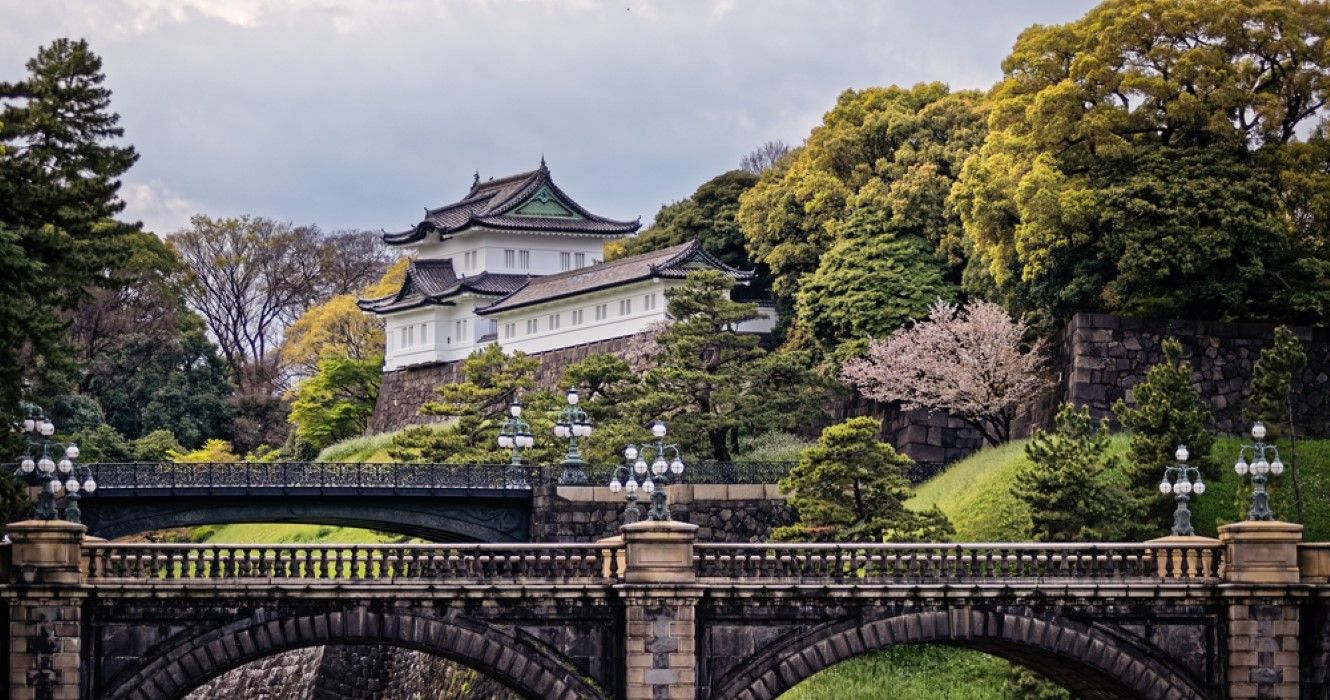Quick Links
The tranquility of the Tokyo Imperial Palace and its grounds is remarkable, given its proximity to the city center. Located in the Chiyoda neighborhood in the Chiyoda ward of Tokyo, this huge park-like location is the primary residence of the Emperor of Japan, just ten minutes away on foot from Tokyo Station and the high-rise Marunouchi financial sector.
The Tokyo Imperial Palace stands in the geographical and symbolic center of Japan on the site of the ancient Edo-jō, the castle of the Tokugawa shogunate. The palace complex consists of multiple structures, including the Emperor's residence (Fukiage Palace, Fukiage Gosho), the main palace where various ceremonies and receptions occur, and the dwellings of members of the Imperial Family, an archive, museums, and administrative offices.
The Palace's Rich Historical Roots
The grounds of the Tokyo Imperial Palace have a rich history dating back centuries. Once located here, the Edo Castle served as the official residence of the Tokugawa shoguns from the early 17th century until the shogunate was abolished in 1868. After earthquakes and fires destroyed many buildings in Edo, the new Japanese Imperial Palace was constructed on the same site during the reign of Emperor Meiji.
The palace and its outlying structures were crafted from wood in the traditional Japanese style, while the bridges and gates came from iron and stone. Much of the Imperial Palace suffered massive destruction during World War II, but it was swiftly rebuilt in the same style, along with new homes and a palace hall. The Imperial Palace and its gardens were worth more than all of California's real estate during Japan's property bubble of the 1980s.
Today, visitors can only explore a small section of the palace grounds and a few expansive gardens, including a cherry blossom viewing area. The tour takes visitors to the Nijubashi Bridge, the Palace Reception Hall, and the Imperial Household Agency. Every new year, the palace throws a festive celebration during which the Emperor and his family meet the general public.
Visiting The Tokyo Imperial Palace And Its Surrounding Area
The Imperial Palace and its surroundings are home to several worthwhile landmarks that may easily fit into a pleasant day of sightseeing. This area is the most popular jogging route in Tokyo, and for a good reason: the beautiful moats, bridges, and walls of the Imperial Palace make for a wonderful backdrop to a stroll.
A draw in the area is The Imperial Palace East Garden, a large garden located east of the Imperial Palace. Although it doesn't have many notable attractions, it is a pleasant location to wander away from the bustle of Tokyo. The sheer magnitude of the Imperial Palace and its surroundings, as well as Japan's political might, are immediately apparent to anybody who visits. Though it's not the grandest garden in Tokyo, it's a must-see around Tokyo Station.
One of the fascinating places in Japan, the Yasukuni-jinja Shrine/Yushukan Museum is essential for any lover of Japanese history. During World War II, fourteen of Japan's war criminals were convicted and enshrined in Yasukuni-jinja. Beautiful and mysterious, the shrine seems to emanate potent and mysterious energy. The Yushukan Museum, located next door, is where visitors find intriguing exhibits as it displays the nationalist Japanese perspective on the twentieth century, with a particular emphasis on World War II.
The Showa-kan Museum is on the northern side of Kitanomaru-Koen Park, not far from the Yasukuni-jinja Shrine. This museum features artifacts from postwar Japan that shed light on the country's culture and history. The collection is modest in size yet rich in content. The museum provides a great contrast to the Yushukan Museum at Yasukuni-jinja by illuminating the impact of nationalist policies on everyday Japanese life.
A little bit far away from the Imperial Palace is the Zenkoku-Ji Shrine, a Buddhist temple with fascinating architecture. Visit this magnificent temple in the Iidabashi/Kagurazaka neighborhood. There is peace and beauty throughout the halls and gardens.
The compact yet picturesque Hibiya-Koen Park is north of Ginza, Yurakucho, and Tokyo Station. It's a great spot to stop for a rest or have a picnic lunch while sightseeing in the heart of Tokyo. Pick up some takeaway from Ginza's many department store food floors, then relax in the nearby park.
Taking A Palace Tour
The public can visit the Imperial Palace for the birthday of the Emperor on December 23 and on New Year's Day, when the Imperial Family traditionally hosts a reception. The only exceptions to this rule are prearranged private tours.
Tours (lasting approximately one and a half hours) are offered Tuesday through Saturday at 10 am and 1:45 pm, but not on public holidays or mornings from late July to the end of August. They are also not held between December 28 and January 4 or during Imperial Court events.
Guests can make a reservation online, over the phone, or through the mail up to one month in advance (and no later than four days in advance via the website). Visit the Kikyo-mon office (open 8.45 am to noon and 1 pm to 5 pm) to register for a tour up to seven days in advance; walk-ins are welcome if spots are still available.
- Location of the palace: 1-1 Chiyoda, Chiyoda City, Tokyo 100-8111, Japan
- Dining Options Near the Tokyo Imperial Palace: Janoshin is a low-key and unassuming sushi restaurant in Kojimachi that offers excellent value.
- Hotel options close to the Tokyo Imperial Palace: Overlooking scenic Hibiya Park, the Imperial Hotel Tokyo is a grand historic establishment, perfect for a relaxing stay.

